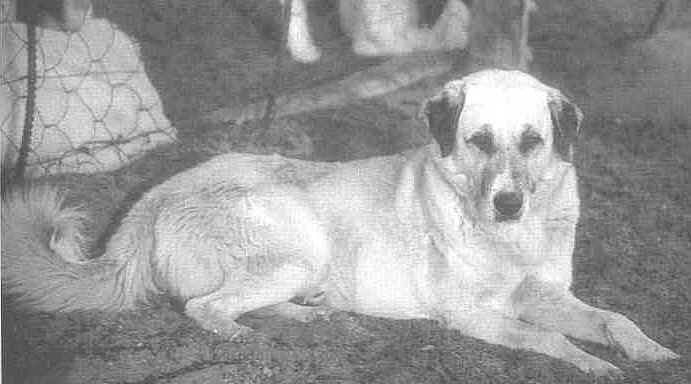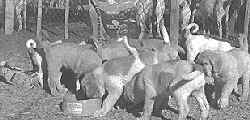![[LOGO]](sm-logo.gif)
![]()
This article is printed with permission from the Cheetah Conservation Fund Newsletter. (see info and link below). The advice within may be specialized or different in certain detail than other successful methods used to train flock guardian dogs. As the article states, the key to success is the dog's manager. You can support the efforts of CCF
via our book sales |
RAISING A GUARDING DOG
– SUCCESS OR FAILURE?
CCF Newsletter No 19, Sept 2003
![[ CCF Zanta with her litter ]](images/ccf-litter.jpg) CCF photo: CCF Zanta - proud mother with her CCF guardian dog litter |
What makes a dog a successful livestock guarding
dog? Although there are factors such as breeding, and training, which contribute to a set
of golden rules that should be followed when raising a livestock-guarding dog, the secret
to a successful working dog is its owner! An owner that is in touch with his dog’s
development, health and progress is the key to ensuring the success of the dog. Just as young growing children go through specific developmental stages, so do all animals. Any parent can tell you about the importance of bonding with your baby, the terrible twos, the dreaded teen years and so on, until maturation takes place – and the raising never really ends. Raising working dogs is no different. |
| The Anatolian Shepherd was imported into Namibia by the Cheetah
Conservation Fund. This breed was selected as it ranks amongst the top third of the most
successful large working breeds and it comes from a similar climate to that of Namibia.
Most importantly, it has an advantage over the many local breeds and traditional mongrels,
in that it is formidable in size and has the courage to match – important when facing
predators such as leopard and cheetah. The Anatolian Shepherd is also rapidly gaining
popularity amongst South African farmers. However, the Anatolian Shepherd is not a wonder-dog that can be thrown together with livestock at any age and left to its own devices. A certain amount of effort and serious commitment are required from working dog owners. The golden rules to raising a successful working dog can be summarised as follows: |
 Flintis - Famous CCF working dog who battled with baboons in Namibia to protect his stock. Photo credit- "Dogs With Jobs: Working Dogs Around the World" by Merrily Weisbord and Kim Kachanofe DVM; Pocket Books, a division of Simon & Schuster, New York; hardcover, 250 pages -- See the book for his amazing story. |
- 1. OWNER
- A successful working-dog owner should be:
- dedicated to making the dog a success;
- available to monitor the dogs progress and guide its development;
- willing to invest time and money into the dogs health, welfare, and development;
- patient and understanding of dogs quirks and needs
- 2. BREED
- When selecting a livestock-guarding dog, an owner needs to ask:
- What are the main predators the dog will need to defend the livestock against?
- What function have the various available breeds been developed for, i.e., working, herding, hunting, etc?
- What are the advantages/disadvantages of the various breeds and their sizes?
- Does the dog come from a proven working line?
Where the problem is smaller predators such as jackal, many of the smaller traditional mongrels, as well as some of the herding breeds will do. Where larger predators such as leopard and cheetah are a problem, then a larger dog will be required. The first step to consider is finding a dog that comes from a proven working line. This is not a guarantee that the dog will succeed, but is the first step along the way, as genetics can play a role.
3. BONDING
Most literature suggests that the critical bonding stage for puppies takes place between six and twelve weeks of age. Therefore, the dog should be living with what it is expected to protect, from the age of 8 to 16 weeks. Ideally, the puppy should be born amongst livestock and raised with them for the rest of its working life. Taking an older dog from a home where it has been bred and raised with a family, and putting it with livestock, is a recipe for failure.
If a dog has been born and raised with goats, it will not easily develop an attachment to a flock of sheep. The livestock a dog is raised with must be considered its family. Dogs should never be moved from their first herd, so make sure you know which herd you want them with when you place the dog. New livestock may be brought into a herd but the dog should always remain with a core group it can identify with, especially if they are animals that it grew up with.
When new livestock are brought in, do remember to integrate them gradually. Some dogs, the Anatolian Shepherd being no exception, will recognise strange livestock as not being part of their "family" and they may try and chase them away, causing injury. Take kraal manure and rub it into the new livestock and keep them amongst some of the herd for a few days before allowing the dog access. If you feel more than one dog is necessary to protect the herd, first acquire one and establish it as a successful working dog, before acquiring a second dog. Raising two puppies together may result in them bonding with one another and not with the livestock.
4. RAISING
A livestock-guarding dog should never be separated from its herd. When still too young to walk out, some members of its herd should always be left with it in the kraal. When still a puppy, lambs or kids are best as the dog then grows up with them and there is mutual acceptance and bonding.
Adult sheep or goats can be quite aggressive with unfamiliar puppies, so protect the puppy until it is mobile enough to avoid them, and the adult livestock have had a chance to become accustomed to the dog. The puppy can be confined in a pen within the kraal when the herd comes into the kraal in the evening. Later, a doorway can be created for the puppy to come and go but which is too low for the adult livestock to access. The pen can also serve as a feeding pen for the dog, so that the livestock do not take its food. Ensure the dog has some supervised contact with the livestock when birthing takes place. Older puppies may become excited with newborn lambs, often attempting to clean newborn livestock (this can assist positively with bonding). However, in the process, they sometimes actively prevent the newborn’s mother from reaching it. Therefore, allow the puppies access to newborn livestock but do supervise them in the beginning.
Puppies should start accompanying livestock at about three months of age but should not be made to walk too far or for too long in the beginning. As the puppy becomes fitter and its feet toughen up, it can walk for longer periods. A dog that is exhausted and foot-sore is not going to want to walk out. Ensure the dog is lead trained at this stage, and that some livestock accompany it if brought back to the kraal.
5. TRAINING
At three months of age and again around six months, some breeds of dogs go through a very playful stage. They may chase livestock around, usually in the early morning and evening hours, when energetic and bored in the kraal. The owner needs to be on the lookout for these stages, as with large breeds like the Anatolian, a six-month-old
puppy can actually play livestock to death. A certain amount of playfulness indicates bonding and that the dog is viewing his livestock as companions. However, an owner should reprimand the behaviour when observed, so that it does not become too boisterous. As a precaution against damage, boisterous dogs can be put on a run-wire or penned within the kraal if adequate supervision is not possible.
When installing a run-wire remember:
- Always ensure the dog has access to water and shade;
- Use a lightweight chain with a swivel clip;
- Ensure the dog cannot reach and try to jump over a fence, or become wounded around any support poles;
- The pegs to which the run wire is attached should be secured below the surface of the ground, to ensure the chain does not get caught on it
- A dog should be lead trained and accustomed to being restrained before being put on a run wire.A good livestock-guarding dog may sometimes injure livestock through boisterous playing but they very seldom eat accidentally killed livestock. If this occurs, however, an owner needs to consider:
- Diet – is nutrition and calcium content adequate for a growing, working dog, especially if it is a large breed?
- Who is feeding the dog, i.e., is the dog receiving the food intended for it?
- Is the dog teething and just chewing on what is available? A dog confined in a kraal with nothing to chew on may also resort to chewing on lambs’ ears! Do ensure you provide bones or rawhide for the dog to chew on at all times.
- Is the dog being adequately supervised?
Note, the dog should never be taken out of the kraal and away from its livestock.
| 6. DIET Working dogs should be fed twice daily. They work day and night so two smaller meals are best. Remember; do not send a dog out in a tough hot climate on a stomach full of dry pelleted food! Always soak food in water before feeding in the morning, as many areas do not have water for the dog to access in the veld. For large breeds of working dogs, Mieleiepap [mealie flour and sweet corn kernel polenta] is not an adequate diet. A working dog’s diet can be supplemented with mieliepap, rice, cooked bones, milk, etc., but the bulk of the diet should be a good brand of pelleted food. |
 CCF photo: CCF Anatolian puppies enjoying food donated by Scientific Veterinary Diet |
http://www.cheetah.org/ama/orig/NamibiaNL0903.pdf
"Reprinted by permission of the Cheetah Conservation Fund (A registered non profit in
the USA, and a registered trust in the UK)
In the USA : CCF, PO Box 1380, Ojai CA 93024 Tel: 805 640 0390; info@cheetah.org; www.cheetah.org
In England: CCF (in partnership with Friends of Conservation UK) Peter Stewart, P. O. Box
151, Godalming, Surrey GU7 2XW, England.
cheeta@appin.demon.co.uk , www.foc-uk.com

This page copyright by Anatolian Shepherd Dogs International, Inc. ® .

